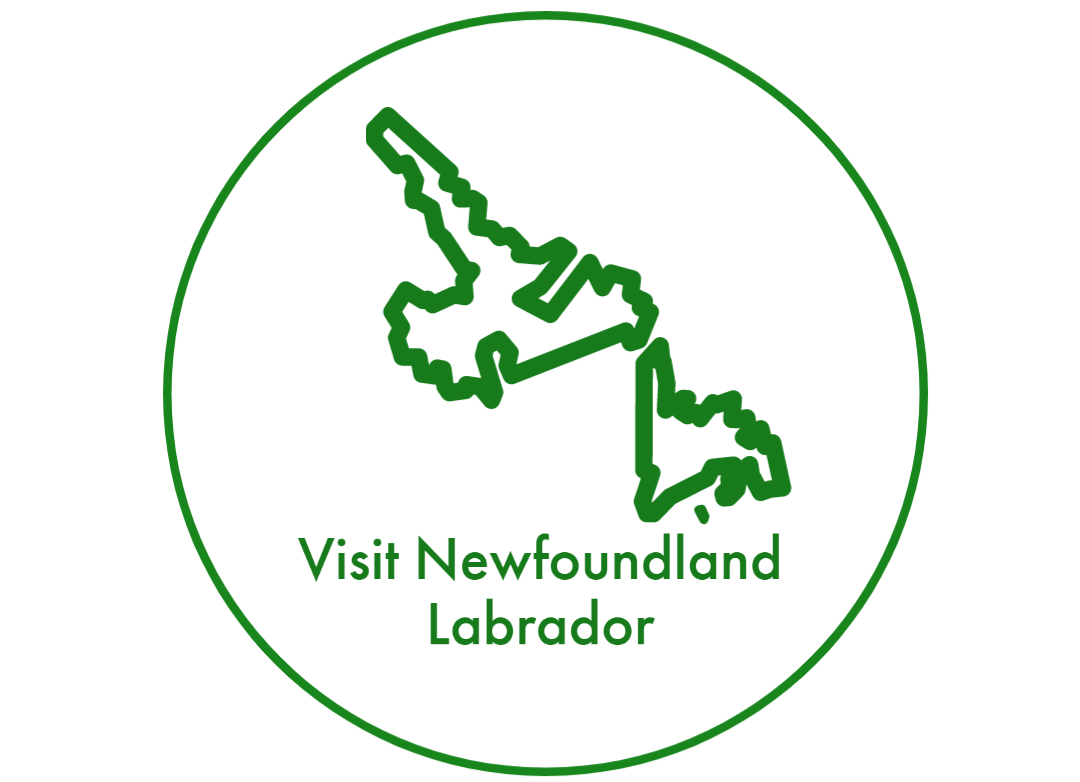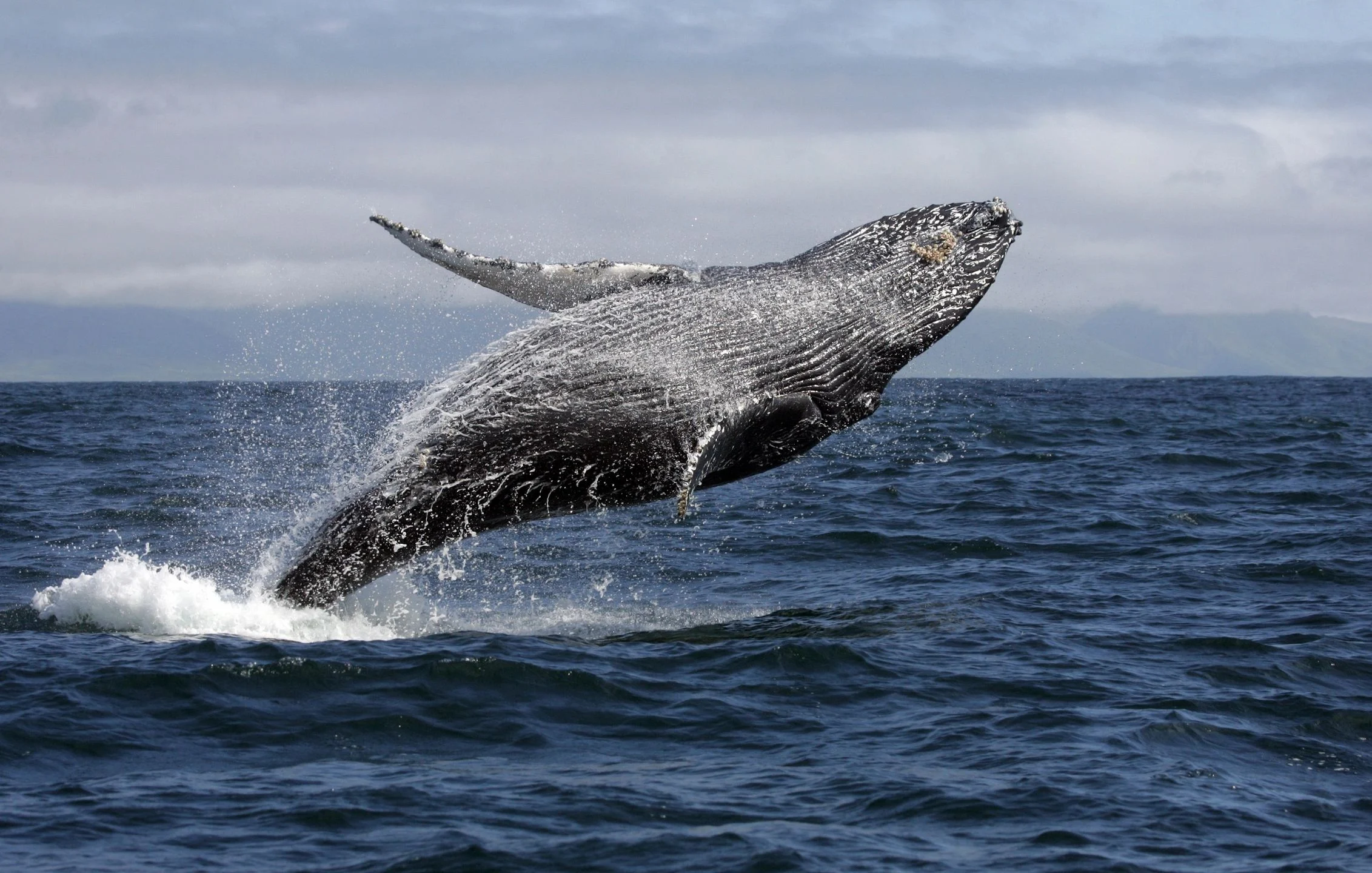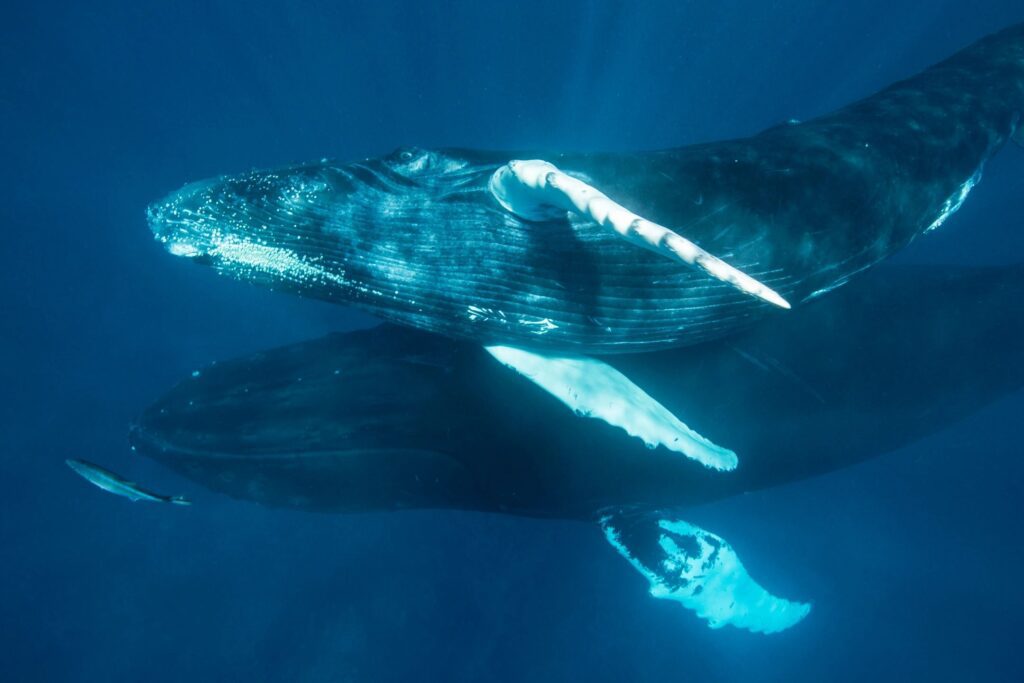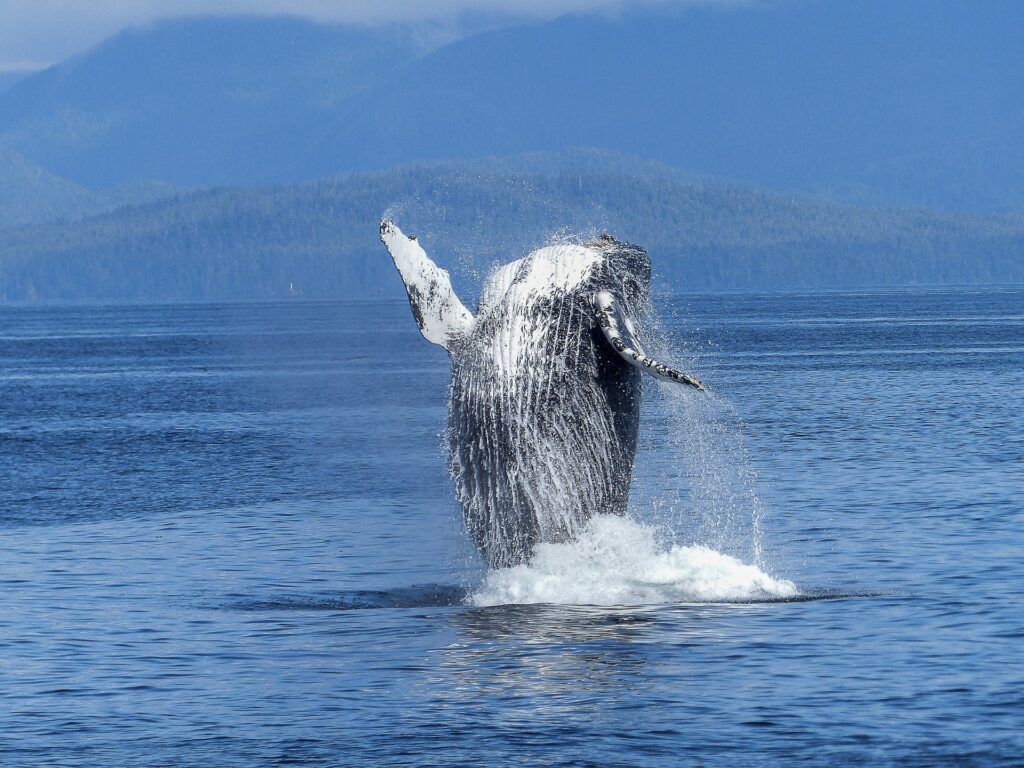A Guide to Experiencing the Thrills of Newfoundland Whale Watching Season
This year, we create A Guide to Experiencing the Thrills of Newfoundland Whale Watching Season. Many people are already planning their next adventure as the summer months approach. And if you’re looking for a truly unforgettable experience, whale watching in Newfoundland is an absolute must. Known as one of the best places in the world to witness these majestic creatures in their natural habitat, Newfoundland offers an unparalleled view of some of the largest mammals on earth.
From humpback whales breaching the surface to minke whales gracefully swimming below, the thrill of seeing these animals up close is an experience that will stay with you forever. But with so many options and tour operators, planning your whale-watching trip can be overwhelming.
That’s why we’ve created this guide to help you navigate the ins and outs of Newfoundland’s whale-watching season, so you can make the most of your adventure and create memories that will last a lifetime. So, get ready to set sail and witness the inspiring beauty of these gentle giants.
When is the best time to go whale watching in Newfoundland?
The best time to watch whales in Newfoundland is from May to September when the whales are most active. During this time, you can witness the whales breaching, feeding, and playing in the waters around Newfoundland. The peak time/season for whale watching is in July and August, but you can still see the whales earlier and later in the season.
One factor that can affect your whale-watching experience is the weather. Newfoundland weather can be unpredictable, so checking the forecast before heading to sea is essential. If the weather is too rough, the tour operators may cancel the tour for safety reasons. But don’t worry; most tour operators offer a full refund or a rescheduled tour if the weather doesn’t cooperate.
Finally, remember that whales are wild animals, and their behaviour can be unpredictable. While tour operators do their best to find the whales, there’s no guarantee you’ll see them on every tour. But don’t let that discourage you, as even the anticipation of seeing a whale is exciting.
What types of whales can be seen in Newfoundland?
Newfoundland is home to several species of whales, including humpback whales, minke whales, fin whales, and orcas. Humpback whales are the most common whales on a whale watching tour in Newfoundland. They’re known for their acrobatic displays, such as breaching, tail slapping, and flipper waving. Humpback whales are also famous for their songs, which can be heard underwater and last up to 20 minutes.
Minke whales are the second most common whale species in Newfoundland. They’re smaller than humpback whales and are known for their streamlined bodies and pointed dorsal fins. Although they’re not as acrobatic as humpback whales, they’re still a sight.
Fin whales are the third most common whale species in Newfoundland. They’re the second-largest whale species after the blue whale and can grow up to 80 feet long. Fin whales are well-known for their long, slender bodies and blowholes. They’re also considered one of the fastest whale species in the ocean.
Orcas, also known as killer whales, are Newfoundland least common whale species. They’re known for their distinctive black-and-white colouring, intelligence, and social behaviour. Orcas are apex predators and can hunt prey, including seals, fish, and even other whales. Every year we create A Guide to Experiencing the Thrills of Newfoundland Whale Watching Season. This is the guide for you.
Where are the best places for whale watching in Newfoundland?
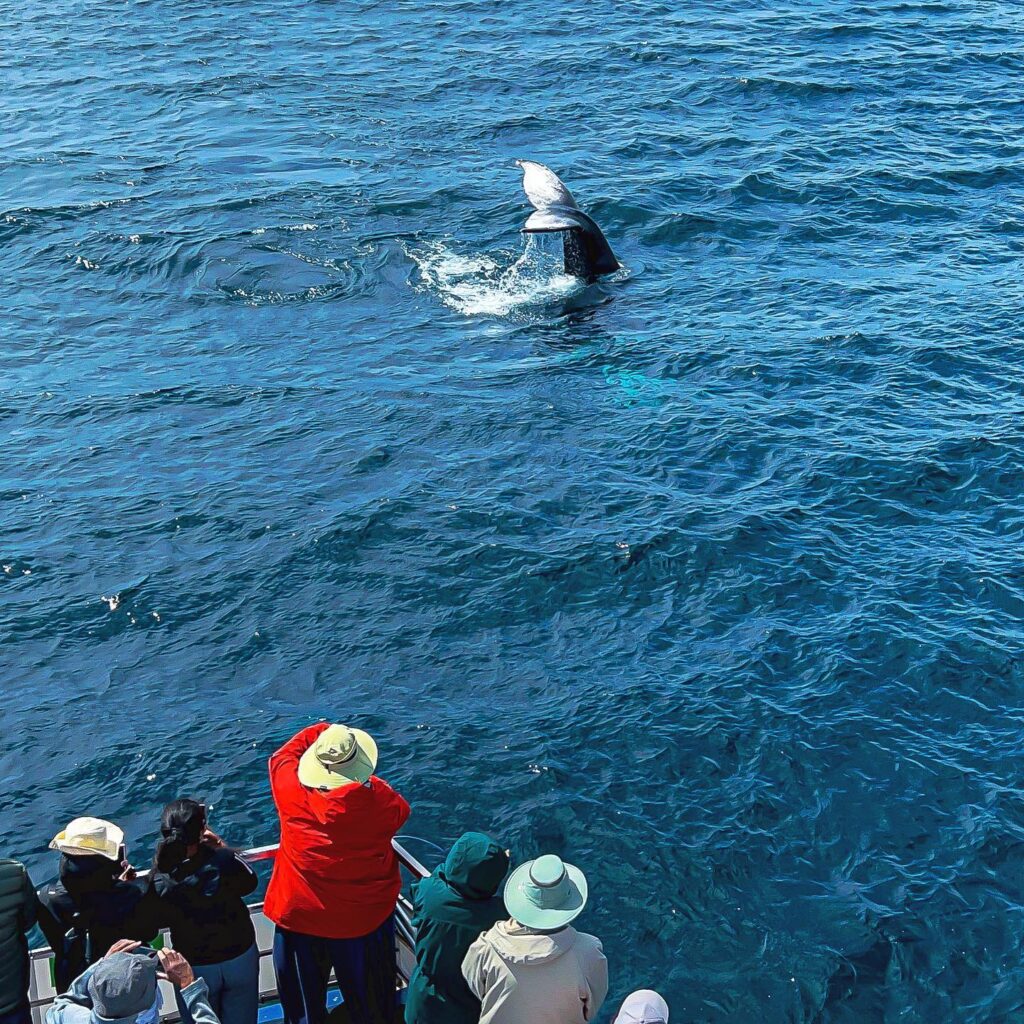
There are several places to go whale watching in Newfoundland, but some are better than others. One of the best places to go whale watching is in Bay Bulls, located about 30 minutes south of St. John’s. Bay Bulls is home to the Witless Bay Ecological Reserve, a protected area home to thousands of seabirds and several species of whales. The tour operators in Bay Bulls offer a variety of tours, including zodiac and larger boat tours.
Another great place to go whale watching is Trinity Bay, about 2 hours from St. John’s. Trinity Bay is home to several species of whales, including humpback whales, minke whales, and fin whales. The tour operators in Trinity Bay offer a variety of tours, including kayaking tours and larger boat tours.
Finally, if you’re looking for a more remote and rugged whale-watching experience, head to the northern tip of Newfoundland to St. Anthony. St. Anthony is home to several species of whales, including orcas, and is known for its stunning scenery and rugged coastline. The tour operators in St. Anthony offer a variety of tours, including zodiac and more extensive boat tours. You can whale watch along Iceberg Alley.
Are there guided whale watching tours in Newfoundland?
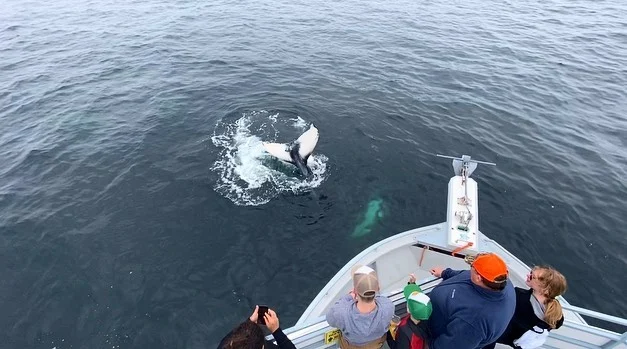
Several tour operators in Newfoundland offer whale watching tours. Some popular tour operators include Gatherall’s Puffin and Whale Watch in Bay Bulls, O’Brien’s Whale and Bird Tours in Bay Bulls, Trinity Eco-Tours in Trinity NL, Ocean Quest Adventures in St John’s, Bonavista Puffin & Whale Tours in Bonavista and Sea of Whales Adventures in Trinity Bay.
Tour operators offer a variety of tours, including zodiac boat tours, larger boat tours, and kayaking tours. The zodiac boat tours are the most exhilarating, as the boats are smaller and can get closer to the whales. The larger boat tours are more comfortable, offering more space and amenities like snacks. The kayaking tours are the most immersive as you paddle with the whales.
Book your tour in advance during the peak season, no matter which tour operator you choose. Most tour operators offer online booking, but you can also book in person at their offices.
What to Expect on a Whale-Watching Tour
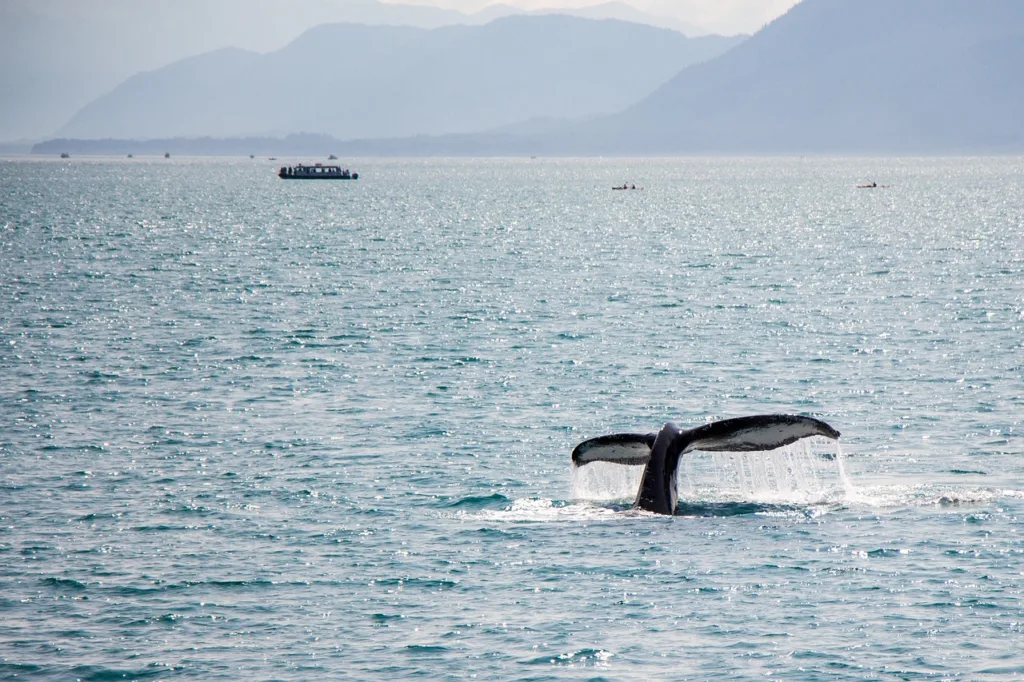
Depending on your chosen tour, you can expect to spend up to 2 to 4 hours on the water. Tour operators will provide you with a life jacket and may also provide you with a waterproof jacket if it’s raining or windy.
Once you’re on the water, the tour operator will search for the whales using various methods, including binoculars, hydrophones, and visual cues like birds and splashing water. When the whales are spotted, the tour operator slowly approaches them, keeping a safe distance to avoid disturbing the animals.
Tour guide on board will inform you about the whales and their behaviour during the tour. They’ll also answer any questions you may have and provide you with interesting facts about the area and its history.
More Newfoundland and Labrador Travel Guides
- Best Towns In Newfoundland For A Relaxing Weekend Getaway
- 8 Gorgeous Beaches in Newfoundland That You Need to Visit
- The best things to do in Twillingate
- Colourful Northern Lights In Newfoundland And Labrador Sky
- The Best Trip Ideas for Newfoundland
- How To Spend 8 Days Vacation In Western Newfoundland
Can I see puffins during a whale-watching tour in Newfoundland?
It’s possible to see puffins during a whale-watching tour in Newfoundland. The coastal waters are home to numerous seabird colonies, including puffins. Keep an eye out for these adorable and colourful birds during your tour.

Tips for a Memorable Whale-Watching Experience
To make the most of your whale-watching experience, here are some tips to keep in mind:
- Dress in different layers because the weather can change quickly. Bring a waterproof jacket, pants, hat, and gloves.
- Take a good camera with a zoom lens to capture the whales up close. If you’re using a smartphone, bring a waterproof case to protect it from the water.
- Listen to the tour guide’s instructions and follow their advice for safety reasons.
- Be patient and watch for any signs of whale activity, such as splashing water or birds hovering over the water.
- Enjoy the moment and take in the breathtaking scenery around you.
Other Activities to Enjoy During Whale Watching Season
While whale watching is the main attraction in Newfoundland during the summer months, there are plenty of other activities to enjoy. Some popular activities include:
- Hiking the East Coast Trail, which is over
- 300-kilometre trail network that stretches along Newfoundland’s coast.
- Visiting the historic town of Trinity, home to several historic buildings and museums.
- Exploring Gros Morne National Park is a UNESCO World Heritage Site known for its stunning landscapes and unique geology.
- Take a boat tour to see the icebergs that float along the coast of Newfoundland during the summer months.
Accommodations and Dining Options in Newfoundland
Newfoundland has a variety of accommodations and dining options to suit every budget and taste. Some popular accommodations include bed and breakfasts, hotels, and vacation rentals. Search and Book Places to Stay in Newfoundland: Where to Stay in St. John’s
Some popular dining options include seafood restaurants, pubs, and cafes. For a unique dining experience, eat a traditional Newfoundland meal, such as fish and brewis, moose stew, or Toutons. Newfoundland is also known for its craft beer and spirits, so try some local brews and spirits during your visit.
Popular dining options
- Chafe’s Landing, Address: 11 Main Road Petty Harbour-Maddox Cove, NL
- Bernard Stanley Gastropub, Address: 223 Duckworth Street, St John’s, NL
- Piatto, Address: 377 Duckworth Street, St John’s, NL
- Ches’s Famous Fish and Chips
Popular brewery options
- Port Rexton Brewing
- Landwash Brewery
- YellowBelly Brewery
- Bannerman Brewing
Whale watching in Newfoundland is an experience that will stay with you forever. From the thrill of seeing the whales up close to the breathtaking scenery around you, Newfoundland offers a truly unforgettable adventure. Following our guide, you can navigate the ins and outs of whale watching season and make the most of your experience. So, pack your bags, book your tour, and get ready to witness the awe-inspiring beauty of these gentle giants.
Thank you for reading. Remember This Is A Guide to Experiencing the Thrills of Newfoundland Whale Watching Season
Travelling to Newfoundland and Labrador. Travelers also ask.
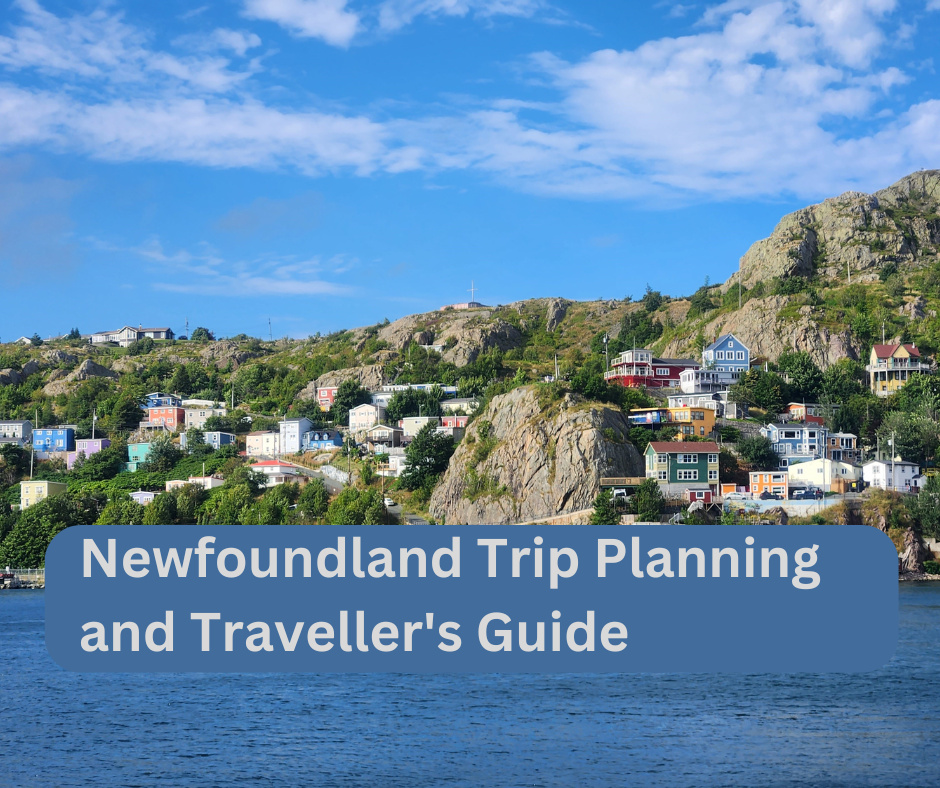
Is St. John’s, Newfoundland, worth visiting?
St. John’s, the capital, is worth visiting. St. John’s offers a rich cultural heritage, a vibrant arts scene, and breathtaking natural landscapes. Known for its colourful row houses, historic sites like Signal Hill, and picturesque harbour, St. John’s provides a unique blend of natural beauty. The city’s friendly locals, lively music scene, and excellent seafood add to its charm, making it a must-visit destination.
What is St. John’s, Newfoundland, famous for?
St. John’s is famous for several things:
- Signal Hill: This historic site offers panoramic views, and the Cabot Tower is where the first transatlantic wireless communication was received.
- George Street is renowned for its nightlife, with the most bars and pubs per capita in North America.
- Colourful Row Houses: Known as Jellybean Row, these brightly painted homes are iconic.
- Rich History: As one of the oldest cities in North America, it has a rich maritime history and cultural heritage.
How many days does it take to visit St. John’s, Newfoundland?
To fully experience St. John’s and its surroundings, a visit of 4 to 5 days is recommended. This allows time to explore the city’s historical sites, enjoy the local cuisine, enjoy the nightlife on George Street, and venture out to nearby natural attractions such as Cape Spear and Quidi Vidi Village.
Is St. John’s, Newfoundland, a walkable city?
Yes, St. John’s is a walkable city, especially in the downtown area, where many attractions, restaurants, and shops are concentrated. The city’s hilly terrain can be challenging, but it also offers beautiful vistas and charming streets to explore on foot.
What is the best month to visit Newfoundland?
The best months to visit Newfoundland are from late June to early September. The weather is milder during this period, and you can enjoy outdoor activities like hiking, whale watching, and iceberg spotting. July and August are viral for tourists.
What is the best time of year to visit St. John’s, Newfoundland?
The best time to visit St. John’s is during the summer, from June to early September, during this this time the weather is warm and many festivals and events occur. This is also the peak season for whale-watching and iceberg viewing.
Is St. John’s Newfoundland expensive?
St. John’s can be moderately expensive, especially during peak tourist season. Accommodation, dining, and activities can add up, but budget-friendly options are also available. Compared to larger Canadian cities, St. John’s is relatively affordable.
Is Newfoundland expensive to visit?
Newfoundland is not excessively expensive to visit, but costs can vary depending on the time of year and type of accommodation. While certain activities and dining experiences may be costly, there are plenty of free or low-cost activities to enjoy.
What is the famous street in St. John’s, Newfoundland?
George Street is famous in St. John’s for its vibrant nightlife and numerous bars and pubs. George Street is a popular spot for locals and tourists looking to experience live music and socialize.
Can you get around St. John’s without a car?
Yes, you can get around St. John’s without a car, especially downtown, where many attractions are within walking distance. You’ll have access to convenient transportation options, such as public transportation, taxis, and ride-sharing services.
How long is the ferry ride from Nova Scotia to St. John’s, Newfoundland?
There is no direct ferry to St. John’s. However, you can take a ferry from North Sydney, Nova Scotia, to either Argentia (a 16-hour ride) or Port aux Basques (a 6–8-hour ride) in Newfoundland. From there, you must drive to St. John’s, which takes approximately 1.5 hours from Argentia or 9 hours from Port aux Basques.
How long does it take to drive around St. John’s?
Driving around St. John’s can take about an hour, depending on traffic and stops. Exploring the greater St. John’s area, including nearby attractions like Cape Spear and Quidi Vidi, can take several hours.
What is the crime rate in St. John’s, Newfoundland?
St. John’s has a relatively low crime rate compared to other Canadian cities. While it experiences typical urban crime, it is generally considered a safe place for residents and visitors.
How cheap is Newfoundland?
Newfoundland is relatively affordable compared to other parts of Canada. While some areas, especially St. John’s, can be expensive, smaller towns and rural areas, however, offer more budget-friendly options for accommodation and dining.
What is the best way to tour Newfoundland?
The best way to tour Newfoundland is by car. This allows you to explore the island’s diverse landscapes, remote villages, and natural attractions at your own pace. Renting a car is recommended if you’re flying into the province.
In what month do you see icebergs in Newfoundland?
Iceberg season in Newfoundland typically runs from late May to early June, though icebergs can sometimes be seen as late as July. The best month for iceberg viewing is usually June.
What is the best month to see icebergs in Newfoundland?
June is generally the best month to see icebergs in Newfoundland. This is when most icebergs drift along the coast, providing spectacular viewing opportunities.
When can I see puffins in Newfoundland?
Puffins can be seen in Newfoundland from late May to early September. The best months to see them are June and July when they are most active during their breeding season.
What is the wettest month in Newfoundland?
October is typically the wettest month in Newfoundland, and it experiences the highest average rainfall.
When can you see whales in St John’s, Newfoundland?
Whale-watching season in St. John’s is from mid-June to mid-August. During this time, humpback, minke, and other whale species migrate through the waters of Newfoundland.
What should I pack for St. John’s, Newfoundland?
When visiting St. John’s, pack layers to accommodate varying weather conditions. Essentials include:
- Waterproof jacket and footwear
- Warm clothing (sweaters, hats, gloves)
- Comfortable walking shoes
- Sunscreen and sunglasses
- Cameras and binoculars for wildlife and iceberg viewing
Can you see the Northern Lights from Newfoundland?
You can watch the Northern Lights (Aurora Borealis) from Newfoundland, particularly in low-light pollution areas. The best time to see them is from late fall to early spring.
Where is the best place to see whales and icebergs in Newfoundland?
Twillingate and Bonavista are Newfoundland best places to see whales and icebergs. These coastal areas offer excellent viewing opportunities and tours.
Are there polar bears in Newfoundland?
Polar bears are occasionally seen in the northern parts of Newfoundland and Labrador, particularly in the Labrador region. They are not commonly found in Newfoundland itself.
How long does it take to drive from one end of Newfoundland to the other?
Driving from the western end of Newfoundland (Port aux Basques) to the eastern end (St. John’s) takes approximately 9–10 hours without significant stops.
Is Fogo Island worth visiting?
Fogo Island is worth visiting for its unique culture, stunning landscapes, and renowned Fogo Island Inn. It offers a distinctive experience of Newfoundland’s heritage and natural beauty.
How often can you see northern lights in Newfoundland?
The Northern Lights can be seen in Newfoundland several times a year, particularly during periods of high solar activity. The best times are during winter when nights are longer and darker.
What is the best time to see the Northern Lights?
The best time to see the Northern Lights is during the winter, from late September to early April, particularly around midnight or early morning.
How long is the ferry ride to Fogo?
The ferry ride to Fogo Island from Farewell, Newfoundland, takes approximately 45 minutes to an hour.
How much is the ferry to Fogo Island?
As of the latest information, the ferry to Fogo Island costs around $15–20 CAD per vehicle and additional fees for passengers, but prices can vary, so it’s best to check current rates.
What is so special about Fogo Island?
Fogo Island is unique for its rugged natural beauty, traditional outport culture, and the acclaimed Fogo Island Inn. It’s known for its artistic community, distinctive architecture, and stunning coastal Scenery.
Are there narwhals in Newfoundland?
Narwhals are typically found in Arctic waters and are uncommon in Newfoundland.
Are there dolphins in Newfoundland?
Yes, dolphins can be seen in the waters around Newfoundland, including species like the Atlantic white-sided dolphin and the common dolphin.
Are there killer whales in Newfoundland?
Killer whales (orcas) are occasionally sighted around Newfoundland, especially during summer.
What is Cape Spear known for?
Cape Spear is known for being the easternmost point in North America. It features a historic lighthouse and offers stunning 180-degree views of the Atlantic Ocean, making it a popular tourist spot.
Where can I see whales in Newfoundland?
Some of the best places to see whales in Newfoundland include:
- St. John’s and Cape Spear
- Trinity and Bonavista
- Twillingate
- Witless Bay Ecological Reserve
How do you see puffins in St John’s?
To see puffins near St. John’s, visit the Witless Bay Ecological Reserve island, which is home to large colonies of puffins. Boat tours from Bay Bulls can take you close to the puffin nesting sites.
How long do you need to see Newfoundland?
Plan to spend at least 7–19 days to see Newfoundland highlights. This allows enough time to explore St. John’s, the Avalon Peninsula, Gros Morne National Park, and other key attractions.
When should I go to Newfoundland?
The best time to visit Newfoundland is from late June to early September when the weather is mild. You can enjoy outdoor activities, events, and festivals. This period is also ideal for whale-watching and iceberg-viewing.
These are the best travel planning resources you should use.
Looking to book your trip to Newfoundland and Labrador? Use these resources that are tried and tested by other travellers like you who vacation in Newfoundland and Labrador. Bookmark these links. Save them for future reference.
Booking Flights, Hotels or B&B: Start planning your next vacation trip by finding the best flight, hotel or b&b deals. Book Here
Finding things to do in Newfoundland and Labrador on TripAdvisor and Viator is not hard. Enjoy boat tours, whale watching, icebergs watching, kayaking and other activities.
You can also find low prices on hotels, B&B and cabins with these two providers. If you are located in Canada, the USA, the UK or Europe, use Booking.com, and if you are in Canada, the USA or anywhere else, use TripAdvisor.
Car Rental: Here is what we recommend:
When you book with Rentalcars.com, you can compare prices and find the best vehicle for your trip. Economybookings.com Display all their vehicle on the website with a detailed description. They display high-quality photos and a user rating as well. Qeeq.com serves road trip travellers like you from different countries by working with car rental companies worldwide.
Get compensated if your flight is delayed or cancel
AirHelp and Compensateair will help you with flight delays, cancellations, or denied boarding. All you need to do is to submit your flight details, and they will handle the claim process on your behalf. They will handle all the paperwork, airline negotiations, and legal proceedings.
Do you need more help planning your trip?
Check out our Resources Page, where we highlight all the resources and companies you can use to assist with your planning.
